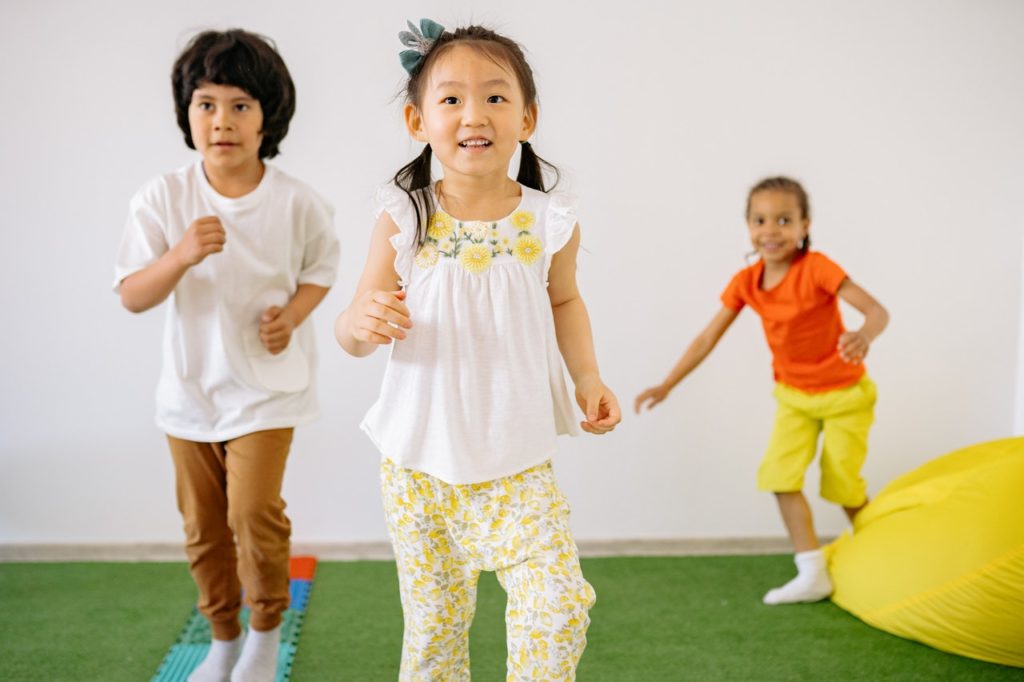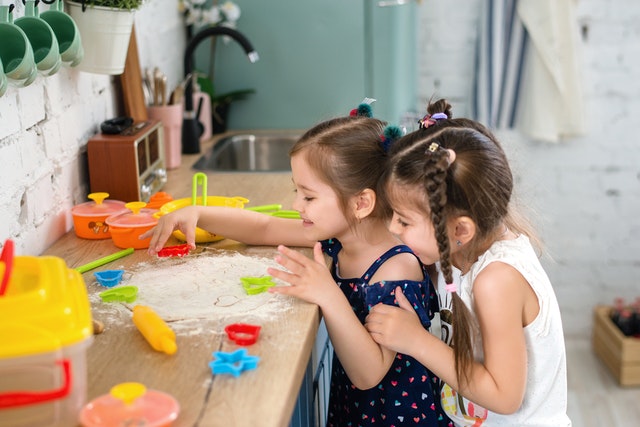Fun Activities & Games, General Information, Help for School and Kindy
Whole Body Learning Provides Healthy Challenges for Kids in Preschool
It’s back-to-school time for our American families and colleagues! Time to park the bicycles, tricycles and scooters. Hang up the swimsuits for a while, and size up your uniforms instead.
Then to dust off your lunch boxes and pencil boxes! We hope you’ve all made good use of your summer vacation together, trying out some fun new ways to explore your neighbourhood.
And perhaps even boosted your brain outside of the classroom with some of our challenges for kids and families. And teachers, we hope you’ve enjoyed a nice break! Are you ready to get back to the work of educating our little ones?
Just because the summer is over, it doesn’t mean you can’t keep your little students physically active and engaged while learning, with the concept of “Whole Body Learning”.

In fact, we highly recommend finding ways to incorporate physical activity in the classroom. Movement games for kids are a fantastic way to keep kids focused on a learning activity.
They offer children with learning disabilities or sensory processing disorder an opportunity to release sensory overload tension. And they’re not just great for children with special needs. Movement games for kids get blood flowing and oxygenating the brain, too.
What’s more? Movement games for kids might just be the trick to teach difficult-to-learn subject matter, too! So, let’s explore the concept of using “Whole Body Learning” to incorporate some extra physical activity in the classroom or home school.
What is Whole Body Learning in the Classroom?
“Whole body learning” is an educational concept. It’s a concept where students use physical activity in the classroom to explore and learn.
Whole body learning includes any type of kinesthetic learning techniques. As opposed to visual or auditory learning styles, kinesthetic learning refers to:
- touching,
- holding,
- experiencing, and
- being physically active
- to explore new concepts
Other learning methods that utilize the concept of whole body learning include:
- Kinesthetic learning
- Hands-on learning
- Visuo-motor learning
- Experiential learning
- Multisensory learning
As one of the three pillars of learning styles, kinesthetic learning presents a new way for students to come to understanding. Muscle memory also helps commit new concepts to memory.
Kinesthetic activities help commit learning into long-term memory. Turning a lesson into a physical experience is not only a good way to keep kids focused and engaged – it’s usually quite fun!
Research Supports Whole Body Learning & Physical Activity in the Classroom
Early childhood educators have been enthusiastic about whole body learning for a long time. A REALLY long time. In fact, wasn’t it Aristotle who said:
“For the things we have to learn before we can do them, we learn by doing them.”
And that was in 350 BCE!
Fast forward quite a bit, and the 1950s-80s gave rise to a deeper exploration into the idea. Psychologists like Jean Piaget, Kurt Lewin, John Dewey and David Kolb all became well known for the role they played in advancing our understanding of how the brain learns through movement and experience.
Kolb summarized his theory by saying:
“Learning is the process whereby knowledge is created through the transformation of experience.”
Pushing the idea further, educators and psychologists of the 1990s-2000s touted the idea that children’s brains receive content in a variety of ways.
Rather than following one specific style of learning (such as visual, auditory, or kinesthetic), it’s instead important to offer multisensory experiences for students to learn.
That’s why today’s teachers have embraced the idea of multisensory learning. A quick search for multisensory activities on Pinterest is most enlightening. It will show you just how creative parents, teachers, and homeschoolers have become!
We have a multitude of research and public awareness in the past 5 years to thank. Taken all together, we’ve seen just how much more effective learning can be when it is impressed through a variety of visual, audio, and sensory introductions.
It makes sense, right? The more senses we involve, the more thoroughly we will grasp a new concept.
So, ‘whole body learning’ is one more way to push this concept forward. Teachers do this by practicing movement games and physical activities for kids to follow along while learning new material.
Add Whole Movement Learning Challenges for Kids to Your Multisensory Activity Toolbox
Let’s explore examples of whole-body learning activities. Here are some ways teachers could introduce learning the letters of the alphabet in physical challenges for kids to try out:
- Tracing alphabet letters in the air with one arm; then the other; then both arms together!
- Balance on one foot and trace the letters of the alphabet. How far can you get before you lose your balance? Practice every day until you can do the whole alphabet on one foot!
- Holding a straw in your mouth, draw your name in the sand.
- Write letters on the ground outdoors with chalk. Then, have the students jump from letter to letter, calling out the phonic sound each makes.
- Write letters on a large beach ball and toss the ball back and forth. When the ball is caught, name the letters touched by the thumbs.
- Set up a series of 5-8 plastic cups with one letter written on each. Have students kick a small ball to knock over a cup or two. They are to name the letter, or calling out the phonic sound each makes.
The Benefits of Whole Body Movement While Learning
Researchers continue to explore the benefits of whole-body learning. As recently as 2017, Florence Bara and Nathalie Bonneton Botte compared visuomotor versus visual-only learning activities in kindergarten. They explain:
“When learning involves both perceptual and motor systems as, for example, with learning letter knowledge, there is an interaction between perception and action. When people perceive objects that can be manipulated, their brains mediate unexpressed mental representations of these manipulative actions”
They go on to explain that this type of brain activity accelerates recognition of new objects later.
For example, when students learn the letters of the alphabet through whole-body learning techniques, the link between body movement and letter recognition makes it easier for them to put together the motor functions required for handwriting.
So, in summary, movement games for kids that echo a specific learning topic benefit students’:
- Deeper understanding of the topic
- Recall of the material later
- Recognition of new material
- Long-term memory of the topic
These types of benefits can make a big difference for a child that struggles with traditional school lessons. If traditional lessons present challenges for kids with or without a learning disability, incorporating whole-body learning might be the solution they need.
After beginning to implement multisensory, whole-body learning into her classrooms, Sarah Major, of Child1st Publications noticed a huge difference. She reflects:
“The difference these teaching elements made on children who were not learning was as dramatic as flipping a switch, turning the room from dark to light. Many children, whether beginners, or those labeled with a variety of disabilities, are benefitting tremendously from being able to learn via pictures, body movement, story, and hands-on activities, all which engage the child and result in learning success.”
Whole Body Involvement to Improve Self-Regulation, Social Communication Skills
So, it’s safe to say that whole-body learning is a great way to boost academic achievement. But we’re also learning that movement games for kids help the brain and body connection in other ways, too.
Penina Rybak, an Autism Specialist and Educational Technology Consultant, encourages teachers and homeschooling parents to utilize whole-body learning for more than academics.
She finds that whole-body learning activities offer an opportunity to practice social play and social communication. They even contribute to improving self-regulation in children who typically struggle with their emotions.
“The key to implementing whole-body learning to improve play and social communication skills is to plan lessons and find specific activities to do which involve:
- Cognitive causality to foster self-regulation and comprehension of time. Including specific related language concepts such as sequencing, verb tense, and inferences.
- Psychological Theory of Mind (perspective/empathy) to promote awareness of the need to transition from Me to We, depending on the situation.
- Fine motor/graphomotor practice to enhance muscle memory and episodic memory, This is regarding: experienced events and associated vocabulary which get paired in the brain’s “cloud storage”.
What is self-regulation, and how can I help to improve it within my students? Explore and download our How Do You Feel Curriculum article
I love the ideas that Rybak suggests for incorporating hands-on learning toys with fun tech apps on the iPad to set up learning experiences through play. For example, playing make-believe kitchen games in an assembly line to “cook” sandwiches or ice cream.
Children learn to switch from individual-focused tasks (adding their “ingredient”) to “other”-focused cooperation (passing the food to the next station and observing how all of the pieces come together to create a meal).

Whole Body Movement Games With Kids Teach Motor Planning, Too
Motor function and planning are such a large component of health development that affect a child’s success in school. (See also our article Midbrain Development Exercises for Boosting Motor Skills Development.)
That’s why we also like to point out that movement games with kids that offer whole body learning are yet another opportunity for teachers and homeschoolers to provide physical activity in the classroom.
In an age when video games and iPads dominate our children’s free time, practically any type of physical movement can be beneficial to their brains and bodies. Whole body learning offers a chance to combine the physical activity our children’s bodies crave, with the mental stimulation their brains crave.
We certainly look forward to seeing how our clever teachers and homeschoolers find ways to incorporate whole body learning into your curriculum this school year.
And be sure to stay tuned to our blog this month, as we’ll be sending out some downloadables. They will be full of whole body learning activities in a wide range of subject matter for you to try at home and in the classroom!
You May Also Like… Related Articles for Teachers & Homeschoolers:
Midbrain Development Exercises for Boosting Motor Skills Development
Download our Curriculum: An Easy and Comprehensive Curriculum for Teaching Self Regulation to Children
How to Keep Kindergarten Children Active and Improve Their Motor Skills at the Same Time
5 Ways Movement Breaks in the Classroom Help With Behaviour
References:
Mikkel M. Beck, Rune R. Lind, Svend S. Geertsen, Christian Ritz, Jesper Lundbye-Jensen, Jacob Wienecke. Motor-Enriched Learning Activities Can Improve Mathematical Performance in Preadolescent Children. Frontiers in Human Neuroscience, 2016.
Mavilidi, MF., Okely, A.D., Chandler, P. et al. Educ Psychol Rev (2015) 27: 413. doi:10.1007/s10648-015-9337-z
Learning Letters With the Whole Body: Visuomotor Versus Visual Teaching in Kindergarten Article in Perceptual and Motor Skills · November 2017 Bara, Florence and Bonneton-Botte, Nathalie.